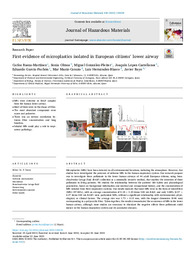Por favor, use este identificador para citar o enlazar este ítem:
https://hdl.handle.net/11000/34880Registro completo de metadatos
| Campo DC | Valor | Lengua/Idioma |
|---|---|---|
| dc.contributor.author | Baeza Martínez, Carlos | - |
| dc.contributor.author | Olmos, Sonia | - |
| dc.contributor.author | González-Pleiter, Miguel | - |
| dc.contributor.author | López-Castellanos, Joaquín | - |
| dc.contributor.author | García Pachón, Eduardo | - |
| dc.contributor.author | Masiá Canuto, Mar | - |
| dc.contributor.author | Hernandez Blasco, Luis M. | - |
| dc.contributor.author | Bayo, Javier | - |
| dc.contributor.other | Departamentos de la UMH::Medicina Clínica | es_ES |
| dc.date.accessioned | 2025-01-18T08:39:08Z | - |
| dc.date.available | 2025-01-18T08:39:08Z | - |
| dc.date.created | 2022-09-15 | - |
| dc.identifier.citation | Journal of Hazardous Materials. 2022 Sep 15:438:129439 | es_ES |
| dc.identifier.issn | 1873-3336 | - |
| dc.identifier.issn | 0304-3894 | - |
| dc.identifier.uri | https://hdl.handle.net/11000/34880 | - |
| dc.description.abstract | Microplastics (MPs) have been detected in all environmental locations, including the atmosphere. However, few studies have investigated the presence of airborne MPs in the human respiratory system. Our research purpose was to investigate these pollutants in the lower human airways of 44 adult European citizens, using bronchoalveolar lavage fluid (BALF) collection as a minimally invasive method, that enables the detection of these pollutants in living patients. We studied the relationship between the patients' life habits and physiological parameters, based on background information and medical and occupational history, and the concentration of MPs isolated from their respiratory systems. Our results indicate that most MPs were in the form of microfibers (MFs) (97.06%), with an average concentration of 9.18 ± 2.45 items/100 mL BALF, and only 5.88% (0.57 ± 0.27 items/100 mL BALF) were particulate MPs, without a significant relationship with environmental, physiological, or clinical factors. The average size was 1.73 ± 0.15 mm, with the longest dimension (9.96 mm) corresponding to a polyacrylic fiber. Taken together, the results demonstrated the occurrence of MPs in the lower human airway, although more studies are necessary to elucidate the negative effects these pollutants could induce in the human respiratory system and its associated diseases. | es_ES |
| dc.format | application/pdf | es_ES |
| dc.format.extent | 12 | es_ES |
| dc.language.iso | eng | es_ES |
| dc.publisher | Elsevier | es_ES |
| dc.rights | info:eu-repo/semantics/openAccess | es_ES |
| dc.rights | Attribution-NonCommercial-NoDerivatives 4.0 Internacional | * |
| dc.rights.uri | http://creativecommons.org/licenses/by-nc-nd/4.0/ | * |
| dc.subject | Airborne microplastics | es_ES |
| dc.subject | Microfibers | es_ES |
| dc.subject | Bronchoalveolar lavage fluid | es_ES |
| dc.subject | Human lung | es_ES |
| dc.subject | Environmental exposure | es_ES |
| dc.subject | Public health | es_ES |
| dc.title | First evidence of microplastics isolated in European citizens' lower airway | es_ES |
| dc.type | info:eu-repo/semantics/article | es_ES |
| dc.relation.publisherversion | 10.1016/j.jhazmat.2022.129439 | es_ES |

Ver/Abrir:
First evidence of microplastics isolated in European citizens’ lower airway.pdf
5,09 MB
Adobe PDF
Compartir:
 La licencia se describe como: Atribución-NonComercial-NoDerivada 4.0 Internacional.
La licencia se describe como: Atribución-NonComercial-NoDerivada 4.0 Internacional.
.png)